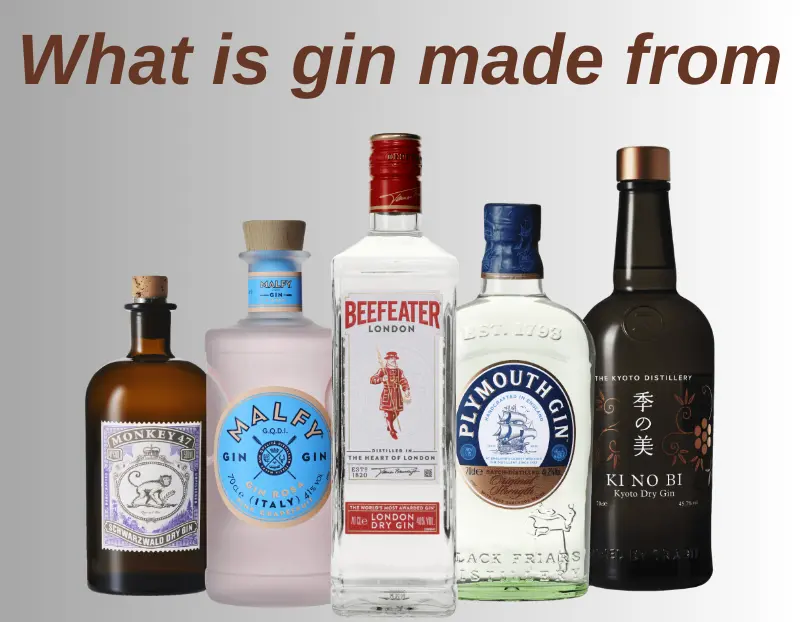Among the most drank spirits worldwide and in Australia is gin; its unique taste makes it a versatile ingredient for cocktails and mixed beverages. But have you ever really considered What is gin made from? The basic elements and the method followed in creating this great soul will be discussed in this article.
What is gin?
Gin is a unique taste distilled alcoholic beverage mostly derived from juniper berries. Though the fundamental alcohol is usually neutral, gin sets other spirits chiefly by its infusion with botanicals, mostly juniper, which produces their own taste. Although production methods have evolved significantly, gin’s history dates back to the 17th century.
What are the main ingredients in gin?
While the ingredients in gin can vary, a few essential components are almost always required:
1. Juniper berries
Gin is primarily made from juniper berries, which give it a clear, piney flavour with a slight spiciness. Without juniper, a spirit cannot legally be called gin.
2. Botanicals
In addition to juniper, gin typically includes other botanicals, which may include:
Coriander seeds: From coriander seeds, a strong, spicy accent comes.
Angelica root: Angelica comes from earthly and quite austere roots.
Orris root: Acting as a fixative, orris root ties other tastes together and adds floral overtones.
Citrus peels: Citrus peels taste really sour and fresh. most especially with oranges and lemons.
Cardamom, cinnamon, or nutmeg: Of the spices, nutmeg, cinnamon, and cardamom radiate warmth and richness.
3. Neutral spirit
Usually starting with a neutral grain alcohol, gin is initially high strength distilled. The botanicals have a blank canvas from which to blossom from this very tasteless alcohol. Usually, common grains like barley, wheat, or corn are used in the manufacture of neutral spirits.
4. Water
During distillation, water is added to reduce the alcohol content to the desired level, typically around 40% alcohol by volume (ABV), making it suitable for drinking.
The process of making gin
Gin production involves several key steps, from creating the base alcohol to infusing the botanicals:
Fermentation
Gin sprang from grains fermenting like barley or corn. Yeast turned carbs into alcohol when mixed into a grain mash. Low-proof alcohol produced here will be used to make gin.
Distillation
The fermented liquid is then distilled to produce a neutral spirit. Distillation involves heating the liquid to separate alcohol from water. This process results in a pure, high-proof alcohol.
Infusing botanicals:
Botanicals comprising juniper berries are mixed with neutral alcohol both during and after distillation. Here two main strategies are applied:
- Steeping method: Botanicals are steeped in the neutral spirit, allowing the alcohol to absorb the flavours.
- Vapour infusion method: The botanicals are placed in a basket, and alcohol vapours pass through, capturing the botanical flavours.
Dilution
Often stronger than 40% ABV, high-proof alcohol is diluted with water during distillation to get drinking levels. This comes last, not too far before the gin forms bottles.
What types of gin are there?
Every one of the various gin variations has unique qualities. Out of the most often used variants are:
London dry gin
London dry gin is not obliged to be brewed in London despite its name. This gin defines itself by strong juniper taste and low sugar level. Artificial tastes or hues cannot allow London dry gin to exist.
Plymouth gin
Made in Plymouth, England, Plymouth gin tastes earthy and sweet differently than London dry gin. Still additional herbal mix enhances its special taste.
Old Tom gin
Still sweeter with more character is Old Tom gin. Typical all through the 18th and 19th centuries, it has lately been very rare. For classic gin beverages such as the Tom Collins, this is an excellent choice.
Navy strength gin
Usually having a 57% ABV, Navy strength gin is a higher-proof variant of gin. Its use historically by the British Navy helped to define it as “navy strength”. A cocktail’s extra booze calls for a bold decision.
How to enjoy gin
There are many ways to enjoy gin, depending on your personal taste and the occasion.
Gin and tonic
Australians especially like the classic gin and tonic water mix. The severeness of the tonic is softened in the gin by the juniper and citrous fragrances. A slice of lime or cucumbers will accentuate the tastes.
Gin cocktails
Gin tastes great in various kinds of beverages if you are adaptable. Some well-known gin-based beverages consist in:
Martini: Martini combines gin and vermouth really brilliantly.
Negroni: Great mix of campari, gin, and sweet vermouth.
Tom Collins:Tom Collins is a rejuvenating drink made of gin, lemon juice, sugar, and soda water.
On the rocks
Favour intricacy hence you should favour gin above ice. This enables you to enjoy the botanicals free of any taste-depleting toxins.
FAQs
Is gin gluten-free?
Usually made from gluten-containing grains like barley or wheat, gin is great for most gluten-sensitive people since the distilling process removes most of the gluten. Should you have celiac disease or a severe gluten allergy, you can utilise gins derived from gluten-free foods such potatoes or grapes.
Does gin have added sugar?
London dry gins include most gins excluding additional sugar. Some varieties, especially Old Tom gin, could taste rather sweet from more sugar or higher botanical concentration.
Can you make gin at home?
In Australia, distribution of alcohol without a licence is illegal. Although you are legally able to include botanicals to buy alcohol to get a gin-like taste, genuine gin manufacture demands for a licensed distillery.
Conclusion
Driven from neutral grain alcohol, gin is a sophisticated and aromatic drink mixed with juniper berries and other botanicals. Whether your taste is for a traditional cocktail or a revitalising gin and tonic, knowing what gin is made of helps you to appreciate the workmanship behind this well-known drink. Australia’s growing love in handcrafted gin implies that there are several regional variants to investigate, each with a unique flavour impression. Cheers to discovering your favourite gin!






